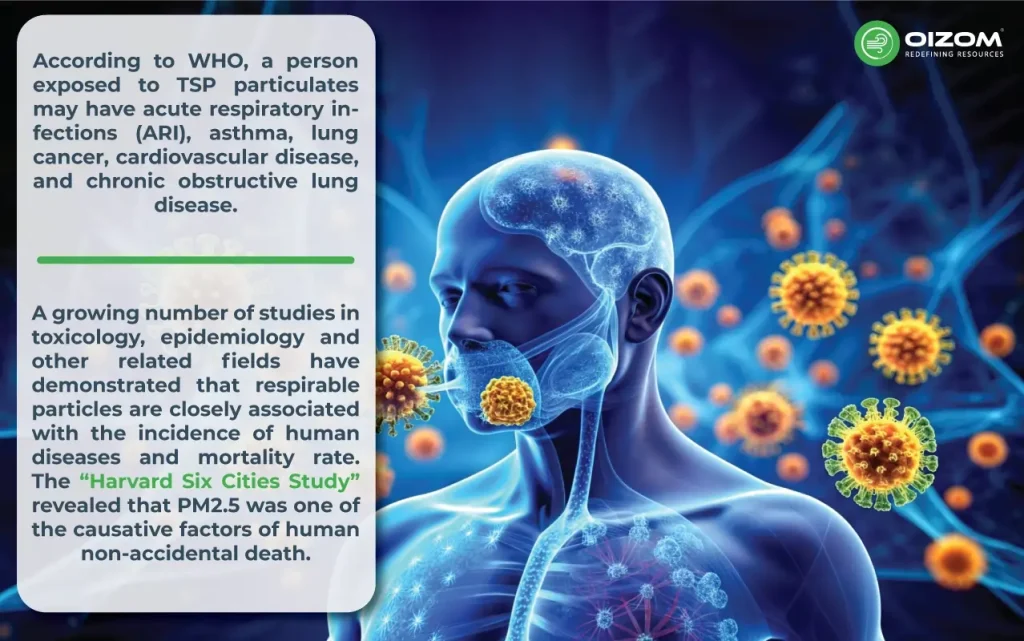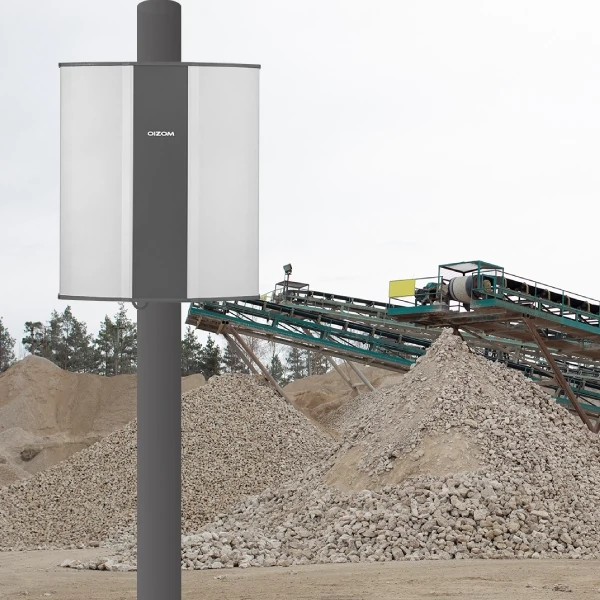Suspended Particulate Matter refers to all solid and liquid particles suspended in air, many of which are dangerous. Dust, pollen, soot, smoke, and liquid droplets are among the organic and inorganic particles in this complex mixture. The size, nature, and origin of these particles vary widely. However, the tiny ones are the most dangerous to our health. However, Air quality conditions can change rapidly. Having a better idea about air quality in your area can better inform you how to reduce your exposure to polluted air.
Government health legislation typically does not recognize particles larger than 10µm since our nose and throat filter them out. On the other hand, TSP is more of a nuisance dust than a health issue. TSP, on the other hand, encompasses all particle sizes. Therefore, the hazards associated with PM10 and PM2.5, such as major respiratory and cardiovascular disorders, also apply. These suspended particulates are 25 to 100 times thinner than human hair (which is why we can’t see it). They can travel into the respiratory tract, penetrate deep into the lungs and even into the bloodstream and cause severe health damage. This blog will provide complete information regarding the health effects of TSP, which are discussed below.

Short-term health effects of TSP
Short-term exposure to total suspended particles (TSP) can harm your health in various ways, including effects on your respiratory system, coughing, eye irritation, and allergic reaction systems. The degree of these effects is determined by several factors, including:
Respiratory problems
Irritation of the airways can cause coughing, wheezing, shortness of breath, and chest tightness. TSP can cause lung inflammation, lowering lung function and making breathing more difficult. Exacerbation of pre-existing respiratory conditions: People with asthma, chronic obstructive pulmonary disease (COPD), or other respiratory issues may aggravate their symptoms.
Irritation of the intestinal and stomach lining
The claim that total suspended particles (TSP) can directly induce intestinal and stomach lining discomfort is not substantiated by substantial scientific evidence. While there is a definite correlation between TSP exposure and respiratory disorders, the influence on the digestive system is less obvious and warrants further investigation.
Here’s why the statement should be scrutinized:
- TSP enters the body predominantly by inhalation, reaching the lungs and respiratory tract. The predominant route of exposure for the digestive system is through swallowed food and drink rather than through inhaled particles.
- Particle size: Larger TSP particles are unlikely to pass through the lungs and into the bloodstream, where they will eventually reach the intestines. Smaller particles (PM2.5) may theoretically enter the bloodstream, but their direct influence on the stomach lining has yet to be established.
- Inadequate research: While some studies reveal a probable link between air pollution and gastrointestinal problems, the evidence is unclear and needs further investigation. Existing research frequently focuses on TSP’s respiratory effects.
Coughing
Consider sandpaper rubbing on your airways. That’s how inhaling TSP feels. These microbes irritate the linings of your nose, throat, and lungs, causing coughing, wheezing, and shortness of breath. It’s like a constant tickling in your respiratory tract.
Throat pain and swelling
The pain does not end with the upper airways. TSP particles can irritate and expand your throat, swelling your eyes. Redness, watering, and irritation. Affecting your vision and adding to the discomfort.
Lactic acid reduction in muscles
There is currently little scientific data to support the claim that total suspended particles (TSP) can produce lactic acid decrease in muscles. While there is a definite correlation between TSP exposure and a variety of health problems, including respiratory and cardiovascular disorders, the influence on muscle function and lactic acid metabolism is unknown.
Eye irritation
The short-term health effect of Total Suspended Particulates (TSP) exposure can cause eye discomfort. These tiny airborne particles, a mixture of solid and liquid droplets, can have various unpleasant and potentially hazardous effects on your eyes.
Causes of eye discomfort include:
- TSP particles can potentially irritate the delicate surface of the eyes, especially the cornea and conjunctiva. This might cause a foreign body sensation (If something is rubbing against your eyes when you blink) and redness and stinging or burning sensations.
- Some TSP components, such as sulphur dioxide or nitrogen oxides, might react with tears and eye secretions, causing an inflammatory response. This can result in increased redness, oedema, and tear production.
Allergic reactions: Inhaling TSP can cause an allergic reaction in the eyes, causing symptoms such as itching, watery eyes, and swollen eyelids in persons with allergies.
Allergic reactions
TSP exposure causes a different health effect for certain people – an allergic storm. Runny noses, itchy eyes, and even wheezing can caused. This is your immune system overreacting to these small pathogens.
Long-term health effects of TSP
The tiny particles suspended in the air, known as Total Suspended Particulates (TSP), present long-term severe health hazards. These particles, which are sometimes overlooked in our day-to-day activities, have a profound impact on human health and can cause various chronic disorders. Their effects range from minor, transient discomforts like coughing or irritated eyes to severe, life-threatening illnesses. The long-term impacts of TSP on human health are examined in this article.
Chronic obstructive pulmonary disease (COPD)
TSP is essential in developing and worsening COPD, a severe respiratory illness. TSP causes damage and restriction of the airways by damaging lung tissues and airways, making breathing more difficult. COPD can dramatically affect one’s quality of life over time, limiting everyday activities and creating significant distress.
Heart disease
TSP has an effect on the heart as well as the respiratory system. Inhaling these particles may cause inflammation and blood vessel damage. This damage can cause high blood pressure, atherosclerosis (hardening and narrowing of the arteries caused by plaque buildup) (made up of deposits of cholesterol and other substances in the artery.), and an increased risk of heart attack and stroke.
Cognitive decline
Emerging evidence reveals a relationship between TSP exposure and memory loss, including Alzheimer’s disease and dementia. Although the specific mechanisms are unknown, it is thought that the inflammation and oxidative stress induced by these particles lead to cognitive function degradation.
Acute respiratory infections (ARI)
TSP increases the likelihood of ARIs by weakening the respiratory system. The irritation and damage to the airways make them more vulnerable to infections, increasing the occurrence of illnesses such as the common cold, influenza, and pneumonia.
Asthma
For individuals with asthma, TSP can be particularly harmful. Exposure to these particles can trigger more frequent and severe asthma attacks, complicating the management of the condition and affecting the overall quality of life.
Emphysema
TSP is a substantial risk factor for emphysema, a disorder in which the lungs’ air sacs are destroyed. This injury impairs the lungs’ ability to give enough oxygen to the body, resulting in extreme weariness and dyspnea.
Chronic obstructive lung disease
This word refers to a variety of lung disorders, including COPD and emphysema. TSP exposure considerably increases the chance of acquiring these illnesses, emphasising the threat these particles bring to lung health.
Conclusion
To summarize, the long-term health consequences of total suspended particles (TSP) are a significant concern. The critical health hazards connected with TSP have been addressed in this blog, including Chronic Obstructive Pulmonary Disease (COPD), heart disease, cognitive impairment, and numerous respiratory infections. Keeping readers informed and interested is critical to effectively conveying the blog’s content. Summarize the significant health dangers, convey a sense of urgency, and encourage readers to take particular steps, such as limiting TSP exposure. Finish with a thought-provoking statement or question that prompts additional reflection or action. This brief conclusion repeats the main message and encourages readers to examine their role in tackling this vital issue.
FAQs
Total Suspended Particulates (TSP) will have several health consequences, especially related to the respiratory and cardiovascular structures. Exposure to TSP is linked to chronic obstructive pulmonary disease (COPD), asthma, and acute respiratory infections. Additionally, these particulates can worsen present lung conditions and contribute to the development of heart illnesses and cognitive decline.
While the primary concerns with TSP are respiratory and cardiovascular effects, extended or excessive exposure to those particulates should potentially worsen the pores and skin. However, compared to the lungs and heart, the pores and skin are much less directly laid low with TSP.
Yes, Total Suspended Particles can substantially contribute to cardiovascular issues. These particulates can cause infection and damage blood vessels, leading to accelerated blood pressure and atherosclerosis. This will increase the threat of heart attacks and strokes.
To guard yourself from TSP, recall:
- Avoid regions with high air pollutant levels when possible.
- Using air purifiers at domestic to reduce indoor particulate levels.
- Wear masks, especially in areas with high pollutants.
- Keep home windows closed during days of excessive pollutants to minimize indoor particulate levels.
- Regularly clean and vacuum to get rid of particulates from indoor areas.
While masks, especially those designed to clear out particulate, rely on N95 respirators and can significantly lessen the inhalation of TSP, they do not offer complete protection. The effectiveness of a mask depends on its kind, proper fit, and constant use in high-risk environments.






